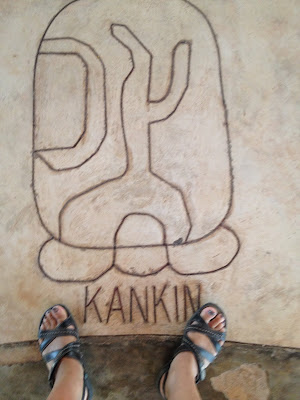Dividing Time
Kankin symbol of the Mayan Calendar, Ek Balam Pyramid site, Mexico, 2015
Remember when the Mayan calendar ended on the Winter Solstice of December 21, 2012 and something catastrophic was to occur in the world? Hmmm... perhaps 8 years later? The interpretation was actually meant to signal the end of a 5000 year calendar cycle and the beginning of a new positive era of transformation for the earth... let's hope the shift is happening! In the photos, we stand on a large circular Mayan calendar near Ek Balam pyramid. These are the astrological symbols for "roughly" our birth months, as the Mayan calendar had 365 days and 18+ months!
As we near the end of 2020, it is interesting to consider the many different cultural calendars and symbols that have evolved over the centuries. Why 12 months in a year, seven days in a week, or 60 minutes in an hour? Calendar inventors were guided by the revolving of the stars, moon, planets, and seasonal cycles to divide time into logical segments. I wonder, as a new calendar was adopted, how the civilizations were able to agree on which day and month should start the year, and even what year it was? Later, yet before computers, there was a precise moment when the world's zones synchronized all clocks... an astounding feat!
I'm glad that, as J.R.R. Tolkien said... All we have to decide is what to do with the time that is given us.
P.S. Watch the skies this Winter Solstice as Jupiter aligns with Saturn to create a Christmas star! This hasn't occurred in nearly 400 years. No telescope required.





This is so cool, all the information you provided and best of all that you had the opportunity to be there and stand on that large circular Mayan calendar near Ek Balam pyramid. What a beautiful experience and memory to hold. I absolutely love your quote - I'm glad that, as J.R.R. Tolkien said... All we have to decide is what to do with the time that is given us.
ReplyDeleteI so want to see that Christmas Star as the planets align.